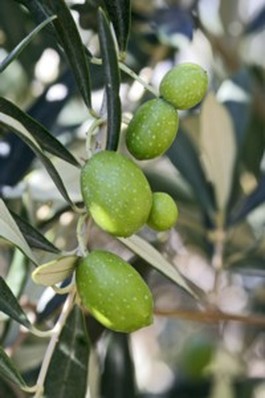Olive Oil Shelf Life and Storage |
|
Olive oil shelf life is affected by several aspects of the production including harvesting, bottling, and storage.

Olive oil has a relatively long shelf life partly due to its high content of mono-unsaturated fat.
BUT...light, heat, and oxygen are all natural enemies of olive oil and contribute to its deterioration. It starts with the olives themselves. Green (unripe) olives have a higher vitamin E and polyphenol content. Vitamin e and polyphenols are anti-oxidants and since oxidization leads to rancidity, more antioxidants means less susceptibility and a longer olive oil shelf life. The length of time between harvest and pressing or crushing is also crucial. The olives should be kept cool and processed within 24 hours or they will start to ferment and oxidize. The extraction process also plays a role in olive oil shelf life. Some techniques subject the crushed olives to more light, heat, and air. Some also add more water to the olive paste during the separation process, which washes away the water-soluble polyphenols. There are brands that state the production date on the container, but many do not. Choose an olive oil that is no more than a year old or buy it from a store where you know the turn over is quick. Avoid bottles that have dusty tops and reach for the bottles on the lower shelves or at the back where there is less light. Fresh products are usually placed at the back or lower shelves. I follow this same rule when buying bread, milk, and many other items. I love the idea of an olive oil of the month club. The product arrives in your home much sooner after harvest than it would have otherwise and you have the opportunity to try many different olive oils without searching all over town or the internet. If you don’t use enough to buy every month, you can opt for a seasonal delivery and receive a fresh supply every few months. Finally, storing olive oil properly once you have it home will minimize deterioration and loss of quality. If you don’t use a lot of olive oil, buy it in smaller bottles. I do encourage you though, to use it in place of other fats whenever possible. Don’t add more fat to your diet by using olive oil, replace it instead. Anyway, I buy 1 litre bottles and that lasts me about a month. It would be fine in a cool dark cupboard, but I pour it into smaller air tight bottles. I leave one in the cupboard for everyday use and the extra goes into the refrigerator. Olive oil turns cloudy and solidifies when it’s stored in the fridge, but it doesn’t hurt the oil and it returns to normal once warmed up again. We eat salad greens with dinner four to five times a week, so we go through a fair bit of salad dressing. I mix up enough of my favourite simple dressing recipe and store it in a ceramic decanter in the fridge. To sum up, olive oil shelf life is dependent on several variables. To help insure you’re getting the most out of your olive oil, keep the following in mind... 5 Simple Rules to Remember for olive oil storage and shelf life:1. Buy fresh extra virgin olive oil.
2. Quality makes a big difference, spend as much as you can afford. 3. Choose opaque or dark coloured containers. 4. Purchase smaller amounts more often. 5. Store it properly once you have it home. |
|
